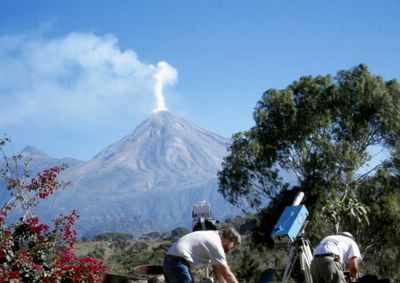Saturday, June 18, 2005
Colima volcanic eruption worries people

Colima volcano raises concerns.

Welcome to Mexico's newest ghost town, permanent home to six stubborn farmers, a few hundred cows and one of the world's most menacing volcanoes.
Authorities ordered the village's other 60 residents, who live only four miles from the volcano's crater, to leave this week after the Colima Volcano thunderously exploded, launching lava and rock miles into the air and covering a large swath of the region with ash.
The explosion last Monday night was the largest for Mexico's "Volcano of Fire" in 20 years.
It was one of a dozen major blasts since May 10 and specialists worry a major eruption is brewing beneath the soil of the tiny Pacific state of Colima that could threaten or disrupt the lives of about 400,000 people.
"We're looking at a (worst-case) scenario compared to what happened at Mount Saint Helens in 1980," said Mauricio Breton, a University of Colima volcano expert who monitors the colossus' activity.
"If that were to happen, the city of Colima would be seriously affected," he said.
At 16 miles from the crater, Colima usually just ignores its picturesque neighbor. But the recent explosions have given residents of the capital a taste of life in the foothills of an active volcano.
"It sounded like a transformer exploding. The windows shook," said Rocio Torres, a Colima resident who used to tell relatives in Mexico City that the volcano didn't worry the people in the city.
"Now there's a lot of panic," she said.
Yet the resilient villagers of the tiny village named after a revolutionary general are more bothered by the evacuation order than the volcano. Most say they have no fear for their safety, and quietly enjoy raising cattle and planting corn on lush hills dotted with large pines and filled with the chirping of brightly colored songbirds.
"They take people out of here almost by force. If everyone could make their own decision, no one would go," said Amador Cardenas, 54, one of the few farmers to defy the evacuation order.
"I'm not going," he said.
Cardenas said he has 346 acres and about 70 head of cattle. He says the rain of ash and the lava-induced fires in the foothills have led to food shortages that have killed at least five of his cows. If authorities wanted to be useful, he said, they'd be more concerned about his livelihood.
"No one worries about the animals. This is an environmental disaster," he said.
The Colima Volcano stands 11,960 feet above sea level and is one of two active volcanoes in Mexico. (The other is about 20 miles from Mexico City). It has a centuries-old history of eruptions but was quiet for most of the 20th century.
Its current rumblings date to 1998 but the last month has been its most active in a generation.
Ash from Monday's explosion covered nearby highways, forced a two-day closure of the Colima international airport and prompted authorities in the state of Jalisco, which borders on the volcano, to recommend school closures until the health-threatening ash could be removed from school grounds.
As of Saturday, Juan Barragan is the only community to have been evacuated.
Specialists say the eruptive period could be either a prelude to a major eruption, like one that occurred in 1913, or just peter out.
"It could last months or days or it could last years," said Breton.
Alberta Altamirano, who claims she is 113 years old, remembers the 1913 eruption like it was yesterday.
"It killed a bunch of cattle down by the river," she said from her home in La Yerbabuena, a community opposite Juan Barragan on the south side of the volcano.
Altamirano said last week that the eruptions don't scare her and she's resigned to her fate should the volcano blow.
"God brought us here, so if the volcano explodes, we'll just burn here," she said with a wrinkled smile.
Not if Civil Protection authorities and the Mexican military can help it. Personnel from both organizations outnumber inhabitants in the handful of towns within five miles of the volcano, and are ready to evacuate, by force if necessary, anyone who stays behind in the event of a major explosion.
This would cause havoc. Civil protection authorities estimate that there are about 25,000 people who would have to be evacuated in the case of a major eruption.
Representatives from both states disagree with the University of Colima's predictions that Colima could be seriously affected. Though believed to be a few miles out of range of lava flows, landslides and flaming projectiles, a heavy layer of volcanic ash could bring the city to a grinding halt.
"But that's a situation. ... that's totally improbable," said Jalisco Civil Protection spokesperson Jorge Sapien.
Judging by the haphazard evacuation of the inhabitants of Juan Barragan, authorities might be counting on the "Volcano of Fire" going back to sleep in the near future.
"It's very disorganized," said Maria Guadalupe Ramirez, 54, about the management at her temporary shelter. She has lived through at least three similar evacuations since 1998 and says this has been one of the worst.
"I hope it's over soon," she said.